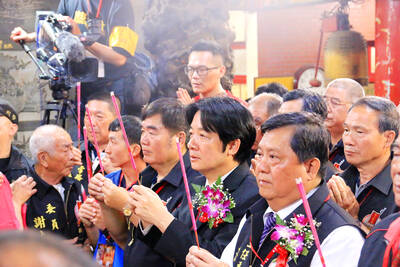For once, the jury got it right.
The 53rd Venice Biennale belonged to Bruce Nauman of the US, and to fail to award him the Golden Lion for best national participation would have been distinctly eccentric. His extended exhibition dominated the Biennale.
The extent of Nauman’s influence on art in recent decades is underlined by a visit to East-West Divan showing work from Afghanistan, Pakistan and Iran in the Scuola Grande della Misericordia. Up the grand staircase of this atmospherically decrepit building hangs a series of chandelier-like neon pieces — a Nauman signature medium — in Islamic script.
Nauman’s tour de force this time was a throwback to Biennales of years gone by, dominated by one towering artist. The late Robert Rauschenberg did so in 1964, signaling the triumph of New York as a cultural capital. I wonder: Will it ever happen again?
At the Peggy Guggenheim Collection there’s a delightful tribute to Rauschenberg, who died last year, in Gluts (through Sept. 20). This series of works from the late 1980s was made of junk metal — street signs, a squashed bicycle, an old fan — riveted together with casual elegance, a terrific eye for color and what can only be called joie de vivre. Though not part of the official Biennale, this is one of the best (modern) things to see in Venice.
For the rest, if not quite Biennale lite, the pickings were on the slim side. In the Arsenale, the exhibition Making Worlds, curated by the Biennale Director Daniel Birnbaum, begins with a beautiful, haunting piece by the Brazilian artist Lygia Pape, who died in 2004, featuring filaments of golden wire gleaming in a darkened room like diagonal shafts of light.
Next comes a piece by Michelangelo Pistoletto, a veteran of the Arte Povera movement, made up of 22 huge mirrors, about half of which were personally smashed in situ by the artist himself (a striking piece of art theater, if nothing else). After that, there wasn’t a great deal more in the echoing length of the old Venetian naval warehouses.
Paul Chan’s Sade for Sade’s Sake (2009), a shadow projection of figures engaged in a variety of sexual activity, understandably created a buzz. Watching all five hours and 45 minutes would be excruciating enough to please the marquis himself. A much pleasanter experience is offered by Cildo Meireles, another Brazilian, in a series of rooms of intensely saturated color — brilliant reds, blues, greens and yellows.
Among the national pavilions, the traditional heavyweights were punching below their usual weights. For the UK, Steve McQueen’s film Giardini was low-key. Liam Gillick, who, though British, was representing Germany, produced an installation of profound dullness with large quantities of timber shelving and a stuffed cat.
Andrei Molodkin, one of the Russian contingent, did better with Le Rouge et le Noir (2009), an installation in which blood and oil, respectively Russian soldiers’ gore and Chechen crude, pump through translucent figures of the Victory of Samothrace. It’s straightforward, yet
makes its point: This is the reality of
military success.
There’s not much painting on view, though Miquel Barcelo for Spain is showing rough-cast pictures and ceramics, somewhere between prehistoric cave art and abstract expressionism. Adel el Siwi in the Egyptian Pavilion also is showing paintings that draw on both national traditions, in his case going back to the Pharaoh Akhenaton and international modern art.
The most positive aspect of the Biennale, which as usual has as much terrible stuff as good, is the way in which contemporary art is an activity in which the whole world is peacefully joining.
For more information, visit www.labiennale.org.

The Democratic Progressive Party (DPP), Chinese Nationalist Party (KMT), and the country’s other political groups dare not offend religious groups, says Chen Lih-ming (陳立民), founder of the Taiwan Anti-Religion Alliance (台灣反宗教者聯盟). “It’s the same in other democracies, of course, but because political struggles in Taiwan are extraordinarily fierce, you’ll see candidates visiting several temples each day ahead of elections. That adds impetus to religion here,” says the retired college lecturer. In Japan’s most recent election, the Liberal Democratic Party lost many votes because of its ties to the Unification Church (“the Moonies”). Chen contrasts the progress made by anti-religion movements in

Taiwan doesn’t have a lot of railways, but its network has plenty of history. The government-owned entity that last year became the Taiwan Railway Corp (TRC) has been operating trains since 1891. During the 1895-1945 period of Japanese rule, the colonial government made huge investments in rail infrastructure. The northern port city of Keelung was connected to Kaohsiung in the south. New lines appeared in Pingtung, Yilan and the Hualien-Taitung region. Railway enthusiasts exploring Taiwan will find plenty to amuse themselves. Taipei will soon gain its second rail-themed museum. Elsewhere there’s a number of endearing branch lines and rolling-stock collections, some

Last week the State Department made several small changes to its Web information on Taiwan. First, it removed a statement saying that the US “does not support Taiwan independence.” The current statement now reads: “We oppose any unilateral changes to the status quo from either side. We expect cross-strait differences to be resolved by peaceful means, free from coercion, in a manner acceptable to the people on both sides of the Strait.” In 2022 the administration of Joe Biden also removed that verbiage, but after a month of pressure from the People’s Republic of China (PRC), reinstated it. The American

Chinese Nationalist Party (KMT) legislative caucus convener Fu Kun-chi (傅?萁) and some in the deep blue camp seem determined to ensure many of the recall campaigns against their lawmakers succeed. Widely known as the “King of Hualien,” Fu also appears to have become the king of the KMT. In theory, Legislative Speaker Han Kuo-yu (韓國瑜) outranks him, but Han is supposed to be even-handed in negotiations between party caucuses — the Democratic Progressive Party (DPP) says he is not — and Fu has been outright ignoring Han. Party Chairman Eric Chu (朱立倫) isn’t taking the lead on anything while Fu